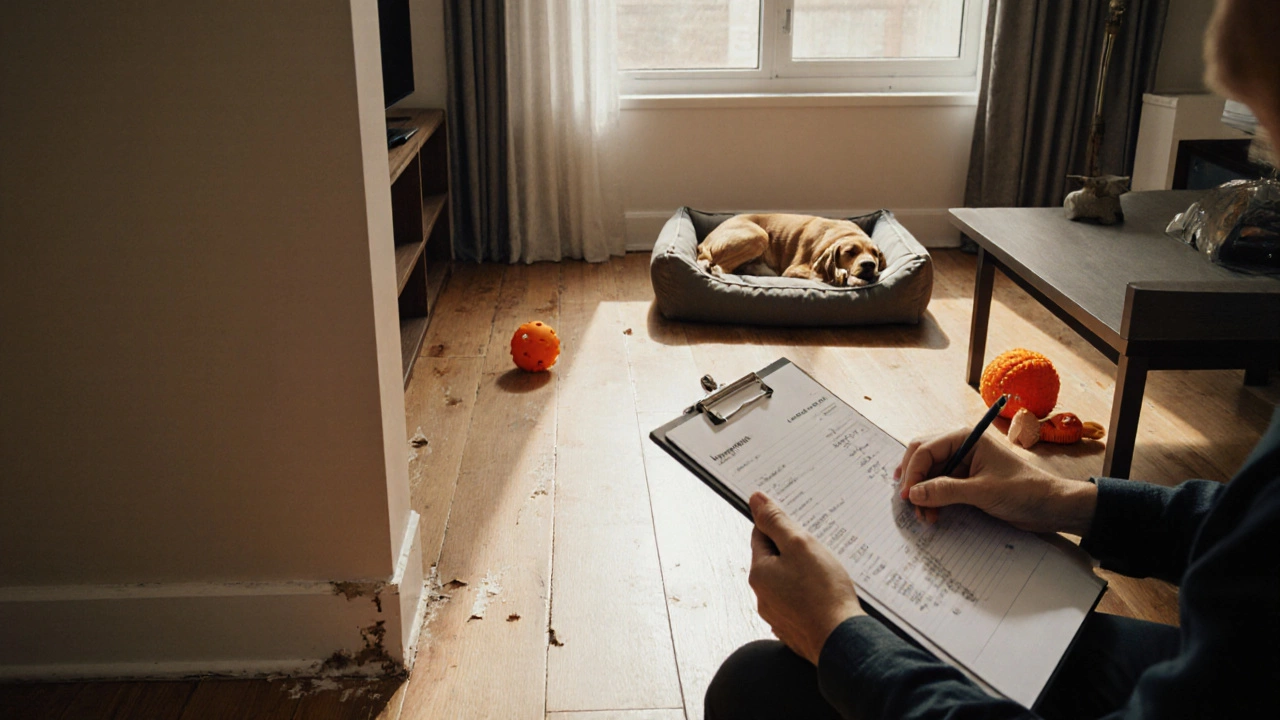Pet Damage Cost Estimator
How Much Does a Pet Really Cost Landlords?
Based on 2024 industry data from the National Association of Realtors and insurance claims. Input your pet details to see realistic repair estimates.
It’s 2025, and more than 65% of U.S. households own a pet. Yet, nearly 40% of rental listings still say no pets allowed. If you’ve ever been turned away from an apartment because you have a dog, cat, or even a rabbit, you’re not alone. But why do so many landlords still say no? It’s not just about bad experiences or personal bias. There are real, measurable reasons-many of them rooted in money, risk, and outdated rules.
Pets Mean More Wear and Tear
Landlords aren’t guessing when they say pets damage property. They’ve seen it. A study by the National Association of Realtors found that rentals with pets had 2.5 times more carpet damage, 40% more scratched flooring, and 30% higher rates of wall stains from accidents. That’s not just cleaning costs. That’s replacement. A dog that chews through baseboards or scratches hardwood floors can cost $800 to $2,000 to fix. A cat that claws up a couch? That’s $500 to replace. For a landlord renting out a $1,200/month unit, a single pet-related repair can eat up months of profit.It’s not just about big damage. Small things add up: pet hair in vents, urine odors in carpets that won’t come out, claw marks on doors, chewed electrical cords. These aren’t always visible during move-in inspections. They show up later-often after the tenant’s security deposit is gone.
Pet-Related Insurance Claims Are Rising
Landlords don’t just worry about damage. They worry about liability. Dog bites are the #1 cause of homeowners and renters insurance claims. In 2024, insurers paid out over $1.1 billion in dog bite claims nationwide. That’s up 18% from 2020. A single incident can raise a landlord’s insurance premium by 20-40% for years. Some policies even exclude certain breeds outright-pit bulls, Rottweilers, and even mixed breeds with those traits.One landlord in Ohio saw his premiums jump from $1,800 to $4,200 a year after a tenant’s dog bit a delivery person. He couldn’t get coverage from his original insurer. He had to switch to a high-risk provider that charged double. That cost? Spread across all his tenants. Many landlords just say no to avoid that risk entirely.
Other Tenants Complain-A Lot
Noise complaints are the #1 reason neighbors report pet owners. Barking dogs, meowing cats at 3 a.m., or even the sound of a hamster wheel spinning all night can trigger a cascade of complaints. In apartment buildings, sound travels. One noisy pet can ruin the experience for 10+ units.A 2023 survey by Apartment List found that 62% of renters said they’d consider moving if a neighbor had a loud pet. Landlords don’t want high turnover. Losing one tenant costs $2,000-$4,000 in cleaning, advertising, and lost rent. One noisy pet can trigger multiple move-outs. That’s why some landlords ban pets before they even get a chance to make noise.
Lease Agreements Are Built for the Old Normal
Many rental contracts haven’t been updated in 10-15 years. They were written when pet ownership was lower, and landlords didn’t have tools to manage risk. Standard leases often say “no pets” because it’s easier than writing custom rules for size, breed, behavior, or vaccination proof.Today, some landlords use pet screening services-like PetScreening or MyPetPolicy-that assess a dog’s temperament, vaccination history, and behavior. But those cost $20-$40 per pet. Most small landlords don’t have the time or budget to set up systems like that. So they stick with the easiest option: no pets.
HOAs and Building Rules Can Force Their Hand
Even if a landlord wants to allow pets, they might not be able to. Homeowners associations (HOAs) and condo boards often have pet restrictions baked into their bylaws. A landlord who rents a condo unit in Florida, for example, might be legally blocked from allowing pets-even if they personally don’t mind them.Some HOAs limit pets by weight (no dogs over 25 lbs), number (only one pet per unit), or breed. Others require proof of training or liability insurance. Landlords who rent in these buildings have to follow the rules-or risk fines, legal action, or even eviction from their own property.
Security Deposits Don’t Cover the Real Cost
You’ve probably heard landlords say, “Just pay a pet deposit.” But here’s the catch: in 21 states, pet deposits are capped at the same limit as regular security deposits-usually one or two months’ rent. That’s $1,200-$2,400 for a $1,200/month apartment.But if a pet causes $3,000 in damage? The landlord can’t recover the full amount. They’re stuck paying the difference. That’s why some landlords charge non-refundable pet fees instead. But even those rarely cover the true cost of repairs, cleaning, or insurance hikes.

Some Landlords Are Changing Their Minds
Not all landlords still say no. A growing number are adopting pet-friendly policies-with conditions. They require pet interviews, proof of vaccinations, or mandatory pet insurance. Some charge a $300-$500 non-refundable pet fee plus $25-$50 monthly rent. Others use pet screening platforms that rate pets on behavior and health.One landlord in Portland started allowing pets after seeing his vacancy rate drop from 22% to 8%. He now has a waiting list of pet owners. He charges a $400 pet fee and requires all pets to be microchipped and insured. His turnover is lower, his renter retention is higher, and he’s made more money than when he banned pets.
There’s also a legal shift happening. In 2024, California passed a law requiring landlords to allow emotional support animals without extra fees. Other states are considering similar rules. More cities are banning breed-specific restrictions. Landlords who resist change are increasingly out of step with tenant demand.
What Pet Owners Can Do
If you’re looking for a pet-friendly place, here’s what actually works:- Prepare a pet resume: Include your pet’s breed, age, vaccination records, training certificates, and references from past landlords.
- Offer to pay a higher security deposit or monthly pet rent-even if it’s not required.
- Propose a pet interview. Bring your dog to meet the landlord. Show how calm and well-behaved they are.
- Use a pet screening service. Some landlords trust third-party evaluations more than a tenant’s word.
- Look for newer properties. Developers building in 2023+ often design units with pet-friendly flooring, fenced balconies, and on-site dog parks.
Don’t just search for “pet-friendly.” Search for “pet-friendly with pet screening” or “no breed restrictions.” Those listings are more likely to be genuinely open.
The Future Is Pet-Friendly
The tide is turning. Renters with pets are not a niche group anymore. They’re the majority. And as more landlords realize that pet owners pay on time, stay longer, and take better care of property, the stigma is fading.Yes, pets can cause damage. But so can kids. So can smokers. So can messy tenants without pets. The difference? Landlords don’t ban kids. They don’t ban smokers. They manage the risk. It’s time they started doing the same with pets.
The landlords who adapt will win. The ones who stick to old rules? They’ll keep losing good tenants to places that welcome them.
Why do landlords charge pet fees if they say pets cause damage?
Pet fees aren’t meant to cover every possible repair. They’re a way to offset the extra cleaning, potential odor issues, and higher insurance premiums that come with pets. Many landlords use these fees to fund a pet damage reserve fund-money set aside just for pet-related repairs. It’s not a guarantee, but it helps them manage risk without raising rent for everyone.
Can a landlord refuse service animals?
No. Under the Fair Housing Act, landlords must allow service animals and emotional support animals, even if they have a no-pets policy. These are not pets-they’re medical aids. Landlords can ask for documentation from a healthcare provider, but they cannot charge extra fees or deposits for them. Refusing a service animal is illegal.
Are certain dog breeds really banned by landlords?
Yes, many still ban pit bulls, Rottweilers, German Shepherds, and others based on outdated stereotypes. But breed-specific bans are increasingly being challenged in court. In 2024, New York City banned breed restrictions in rental housing. Other states are following. Landlords who use breed bans risk legal trouble, especially if the restriction isn’t based on actual behavior.
Do pet deposits get returned?
It depends on the state. In most places, pet deposits are treated like regular security deposits and must be returned within 30-60 days after move-out, minus documented damages. Some landlords charge non-refundable pet fees instead-these are not deposits and are kept regardless of damage. Always check your lease to see what you’re paying and what it covers.
How can I prove my pet is well-behaved?
Bring proof: vaccination records, obedience training certificates, references from past landlords who say your pet was quiet and clean, and even a short video of your pet calmly sitting or lying down. Some landlords will let you bring your pet for a meet-and-greet. A calm, quiet pet can change a landlord’s mind faster than any form letter.


Corbin Fairweather
I am an expert in real estate focusing on property sales and rentals. I enjoy writing about the latest trends in the real estate market and sharing insights on how to make successful property investments. My passion lies in helping clients find their dream homes and navigating the complexities of real estate transactions. In my free time, I enjoy hiking and capturing the beauty of landscapes through photography.
view all postsWrite a comment